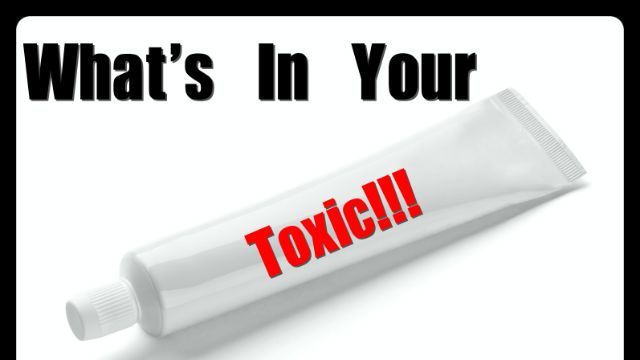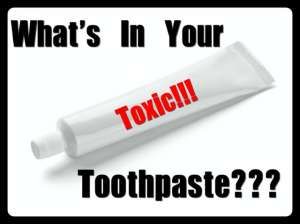
What if we told you that the substance you use to clean your teeth is introducing harmful substances into your body? Most of us who are cautious about our dental health brush our teeth twice a day without exception, and therefore, our bodies are routinely exposed to whatever ingredients are in our toothpaste.
For those of you using chemical-based commercial toothpastes, we have some bad news. There are over 82,000 chemicals allowed in personal care products (including toothpaste) in the United States, and researchers have found that a shocking third of them have links to cancer.
Furthermore, researchers have also found that less than 20 percent of the chemicals found in personal care products have been tested for safety. On top of that, not all chemicals used are required to be on the label. These lax safety guidelines make our personal care products slurries of potential chemical overload.
Of the hundreds, if not thousands, of ingredients found in toothpastes, the following are 10 of the worst.
1. Fluoride
The dangers of fluoride, especially when it is ingested, are becoming increasingly well-known. This byproduct of manufacturing certain metals has been found to have neurotoxic properties, and is linked to raising blood sugar.
Even if you’re not eating it, accidentally swallowing fluoride toothpaste is linked to stomach pain, dizziness, vomiting, headaches and skin rashes.
2. Sodium lauryl sulfate (SLS)
This is the ingredient added to many toothpastes – and a range of other personal care products – to make them foamy. Along with foam, SLS is linked to skin and eye irritation, genetic mutations, hormonal imbalances and cancers.
3. Triclosan
Triclosan is a common ingredient added to toothpastes for its antibacterial properties. However, this ingredient, which originated as a pesticide, has been linked to allergies and hormonal disruption, and is thought to be contributing to the epidemic of antibiotic resistance.
4. Propylene glycol
Also an ingredient found in antifreeze, propylene glycol is added to some toothpastes to act as a surfactant (lowers the surface tension between two substances). Chronic exposure to propylene glycol is linked to liver, kidney and neurological issues.
5. Microbeads
You know those pretty little flecks housed within some toothpaste gels? Those are microbeads, and they not only pollute lake sediment, dentists have found them lodged in people’s gums. A microbead stuck in your gum line can lead to irritation, infection, and even, eventually, periodontal disease.
6. Diethanolamine (DEA)
DEA is a chemical compound that, like sodium lauryl sulfate, causes personal care products to foam. Unfortunately, DEA has also been linked to skin irritation, hormonal disruption, and a potentially higher risk of certain cancers, including those of the kidney and liver.
7. Artificial colorings
Artificial colorings are often petroleum based, and include other industrial chemicals. Many common color combinations have been linked by research to hyperactivity in children, and a risk of severe allergic reactions. Some have been linked to cancers in lab animal tests.
8. Artificial or natural flavors
If you see the terms “artificial flavors” or “natural flavors” on a label, these could be virtually anything. In the case of artificial flavors, they could be derived from a number of chemical ingredients.
Natural flavors are not as natural as you may think – raspberry flavor, for example, is a highly processed derivative of the secretions of the anal scent glands of beavers… really.
9. Hydrated silica
This ingredient is added to some whitening toothpastes, to give it a “scrub” quality to remove stains. Unfortunately, this can also wear down tooth enamel, which can lead to a host of dental issues.
10. Sodium saccharin
This compound is the solid state of the artificial sweetener known as saccharin. Artificial sweeteners have serious potential dangers, and some early animal studies on saccharin linked the compound to bladder cancer.
What to do? Make your own natural toothpaste!
 The following, super-simple toothpaste recipe is a far superior – and highly nutritious – alternative to the commercial varieties, which do not deserve time in our mouths.
The following, super-simple toothpaste recipe is a far superior – and highly nutritious – alternative to the commercial varieties, which do not deserve time in our mouths.
In the following recipe, coconut oil and tea tree oil offer potent antibacterial properties, while baking soda helps to neutralize acid, whiten teeth, and remove plaque and stains. Just mix together:
- 2 tablespoons coconut oil
- 2 tablespoons baking soda
- 5 drops tea tree oil
Optional extras:
- 1 tablespoon of high quality bentonite clay – acts to remove toxins from your mouth.
- 2 drops clove oil – antiseptic and antibacterial properties.
You can make a larger or smaller batch, depending on the size of container you use for storage. Mix the baking soda and coconut oil together until it forms a paste-like consistency, then add the tea tree oil and other optional ingredients.
Your teeth will be sparkling in no time… without the risk.
-The Alternative Daily
Sources:
http://fluoridealert.org/issues/dental-products/toothpastes
http://www.beyondpesticides.org/antibacterial/triclosan-research-3-09.pdf
http://www.medscape.com/viewarticle/508430_8
http://www.sciencelab.com/msds.php?msdsId=9927239
http://downwithbasics.com/the-5-hidden-dangers-in-toothpaste
http://www.livestrong.com/article/167101-what-are-the-harmful-ingredients-in-toothpaste
http://www.thedenverchannel.com/lifestyle/health/dentist-calls-crest-toothpaste-dangerous-now-pg-changing-ingredients
http://healthyeating.sfgate.com/sodium-saccharin-1859.html
https://www.thealternativedaily.com/aspartame-toxic-sweetener-made-gm-bacteria
https://www.thealternativedaily.com/naturalflavoring-made-from-the-anal-secretions-of-beavers

